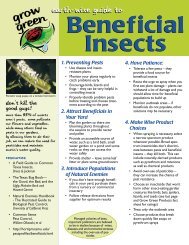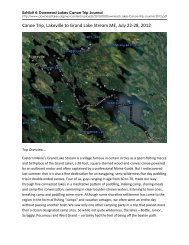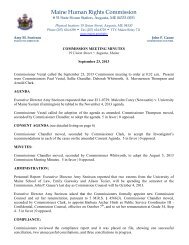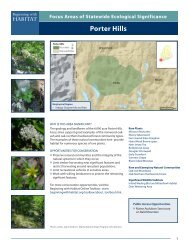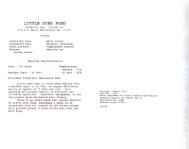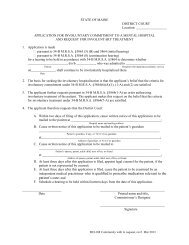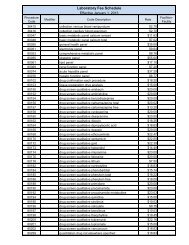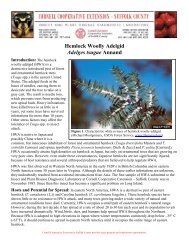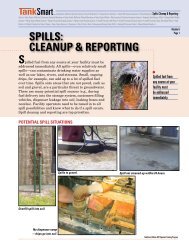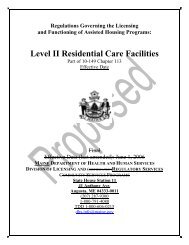TICK-BORNE DISEASES IN MAINE - Maine.gov
TICK-BORNE DISEASES IN MAINE - Maine.gov
TICK-BORNE DISEASES IN MAINE - Maine.gov
Create successful ePaper yourself
Turn your PDF publications into a flip-book with our unique Google optimized e-Paper software.
tick-borne diseases in <strong>Maine</strong><br />
A Physician’s Reference Manual
Deer Tick Dog Tick Lonestar Tick (CDC photo)<br />
Nymph<br />
Nymph<br />
Nymph<br />
Adult Male<br />
Adult Male<br />
Adult Male<br />
Adult Female<br />
Adult Female<br />
Adult Female<br />
images not to scale<br />
Know your Ticks<br />
Ticks are generally found in brushy or wooded areas, near the<br />
ground; they cannot jump or fly. Ticks are attracted to a variety<br />
of host factors including body heat and carbon dioxide. They will<br />
transfer to a potential host when one brushes directly against<br />
them and then seek a site for attachment.<br />
Deer Tick<br />
Ixodes scapularis<br />
(also called blacklegged tick)<br />
Diseases<br />
Lyme disease,<br />
anaplasmosis, babesiosis<br />
What bites<br />
Nymph and adult females<br />
When<br />
Anytime temperatures are<br />
above freezing, greatest<br />
risk is spring through fall<br />
Coloring<br />
Adult females have a<br />
reddish-brown tear shaped<br />
body with dark brown hood<br />
Size:<br />
Nymphs: Poppy seed<br />
Unfed Adults: Sesame seed<br />
Dog Tick<br />
Dermacentor variabilis<br />
(also called wood tick)<br />
Diseases<br />
Rocky Mountain spotted<br />
fever and tularemia<br />
What bites<br />
Adult females<br />
When<br />
April through August<br />
Coloring<br />
Adult females have a dark<br />
brown body with whitish<br />
markings on its hood<br />
Size:<br />
Unfed Adults:<br />
Watermelon seed<br />
lonestar Tick<br />
Amblyomma americanum<br />
Diseases<br />
Ehrlichiosis<br />
What bites<br />
Nymph and adult females<br />
When<br />
April through September in<br />
New England, year-round in<br />
Southern U.S.<br />
Coloring<br />
Adult females have a brown<br />
body with a white spot on<br />
the hood<br />
Size:<br />
Nymphs: Poppy seed<br />
Unfed Adults: Sesame seed
summer fever Algorithm<br />
Algorithm for Differentiating Tick-borne Diseases in <strong>Maine</strong><br />
This algorithm is intended for use as a general guide when pursuing a diagnosis.<br />
It does not replace the physician’s clinical judgment or the need for definitive<br />
laboratory testing.<br />
Patient resides, works, or recreates in an area likely to have ticks and is exhibiting fever,<br />
headache, malaise and/or lymphadenopathy<br />
Does the patient have a rash?<br />
Other Considerations<br />
• Rash occurs in 70-80% of Lyme disease<br />
YES<br />
NO<br />
patients.<br />
• Rash occurs in less than 10% of<br />
Blood smear review<br />
Complete<br />
blood count (CBC)<br />
anaplasma patients.<br />
• Rash occurs in less than 40% of adult<br />
Ehrlichia patients, and less than 60%<br />
of children.<br />
• Rash occurs in 70-80% of RMSF patients<br />
but only appears several days after onset<br />
of febrile illness.<br />
• Hyponatremia may occur with RMSF<br />
or tularemia.<br />
• Lyme disease can present as Bell’s palsy,<br />
Erythema migrans (single or<br />
multiple lesions)<br />
Lyme disease<br />
Maculopapular<br />
May be anaplasmosis (rash is<br />
very uncommon), further tests<br />
needed<br />
Parasites in RBC*<br />
Babesiosis<br />
*If patient has an international<br />
travel history, malaria should<br />
be ruled out<br />
Morulae in WBC<br />
May be anaplasmosis (seen<br />
in less than 50% of serious<br />
cases), further tests needed<br />
Normal CBC<br />
May be Anaplasma, RMSF,*<br />
tularemia**<br />
or Lyme disease, further<br />
tests needed<br />
* RMSF—thrombocytopenia<br />
may be observed<br />
** tularemia—WBC normal or<br />
elevated, thrombocytopenia<br />
may be observed<br />
further tests needed.<br />
• Ulceroglandular tularemia usually presents<br />
as regional lymphadenopathy with a small<br />
ulceration distally, further tests needed.<br />
• Coinfections involving Lyme disease,<br />
babesiosis, and/or anaplasmosis may occur<br />
because a single deer tick may carry<br />
multiple pathogens.<br />
• Consider pneumonic tularemia in any<br />
patient presenting with communityacquired<br />
pneumonia who resides on,<br />
or has recently visited, Martha’s Vineyard,<br />
Massachusetts.<br />
Cutaneous ulcer<br />
May be tularemia<br />
(ulceroglandular), further tests<br />
needed<br />
Maculopapular to Petechial*<br />
May be RMSF, or ehrlichiosis,<br />
further tests needed<br />
*If petechial rash of palm and<br />
sole (characteristic of RMSF)<br />
is present, treat immediately<br />
WBC low or normal,<br />
thrombocytopenia,<br />
low hematocrit,<br />
elevated reticulocytes<br />
May be anaplasmosis or<br />
babesiosis, further tests<br />
needed<br />
Normal hematocrit,<br />
thrombocytopenia, leukopenia<br />
May be anaplasmosis or<br />
ehrlichiosis, further tests<br />
needed
ANAPLASMOSIS (AKA HUMAN GRANULOCYTIC ANAPLASMOSIS)<br />
AGENT<br />
Signs/Symptoms<br />
Labs<br />
Bacteria: Anaplasma phagocytophilum<br />
(formerly Ehrlichia phagocytophilum)<br />
Tick: Ixodes scapularis<br />
[Incubation Period 1-2 weeks]<br />
• Fever, chills<br />
• Severe headache<br />
• Malaise<br />
• Myalgia<br />
• Gastrointestinal symptoms (nausea,<br />
vomiting, diarrhea, anorexia)<br />
• Cough<br />
• Arthralgia<br />
• Stiff neck<br />
• Confusion<br />
Common Findings on Routine<br />
Laboratory Tests<br />
Generally observed during the first week<br />
of clinical disease<br />
• Mild anemia<br />
• Thrombocytopenia<br />
• Leukopenia (characterized by relative<br />
and absolute lymphopenia and a<br />
left shift)<br />
• Modest elevations in hepatic<br />
transaminases<br />
notes<br />
• Visualization of morulae in the<br />
cytoplasm of neutrophils or eosinophils<br />
during examination of blood smears<br />
is highly suggestive of a diagnosis;<br />
however, blood smear examination is<br />
insensitive and should never be relied<br />
upon solely to rule anaplamsa in or out.<br />
• Confirmation of the diagnosis is based<br />
on laboratory testing, but antibiotic therapy<br />
should not be delayed in a patient<br />
with a suggestive clinical presentation.<br />
Diagnostic Laboratory Criteria<br />
• Clinical signs of anaplasmosis and<br />
• Detection of DNA by PCR assay<br />
(preferred method); or<br />
ehrlichiosis are similar, and testing<br />
for both species is indicated due to<br />
• Demonstration of a four-fold change<br />
in IgG-specific antibody titer by IFA<br />
in paired serum samples; or<br />
presence of both tick vectors. Also<br />
consider the possibility of coinfection<br />
with B. microti and/or B. burgdorferi.<br />
• Immunohistochemistry (IHC) staining<br />
of organism; or<br />
• Isolation of organism from a clinical<br />
specimen in cell culture.
ANAPLASMOSIS<br />
treatment<br />
The regimens listed below are guidelines only and may need to be adjusted depending<br />
on a patient’s age, medical history, underlying health conditions, pregnancy<br />
status or allergies. Consult an infectious disease specialist for the most current<br />
treatment guidelines or for individual patient treatment decisions. †<br />
age category drug dosage maximum duration<br />
(days)<br />
Adults Doxycycline 100 mg twice<br />
per day orally<br />
or IV<br />
Children<br />
8 years of age or older<br />
moderate illness<br />
Children<br />
less than 8 years of age<br />
severe illness<br />
without Lyme disease<br />
Children<br />
less than 8 years of age<br />
severe illness<br />
with Lyme disease<br />
Doxycycline<br />
Doxycycline<br />
Doxycycline<br />
Followed by<br />
Amoxicillin<br />
4 mg/kg<br />
per day orally<br />
or IV in<br />
2 divided doses<br />
4 mg/kg<br />
per day orally<br />
or IV in<br />
2 divided doses<br />
4 mg/kg<br />
per day given<br />
orally or IV in<br />
2 divided doses<br />
50 mg/kg<br />
per day in<br />
3 divided doses<br />
N/A 10<br />
100 mg<br />
per dose<br />
100 mg<br />
per dose<br />
100 mg<br />
per dose<br />
500 mg<br />
per dose<br />
10<br />
4-5<br />
OR approx.<br />
3 days after<br />
resolution of<br />
fever<br />
4-5<br />
to complete<br />
a 14 day<br />
total course<br />
of antibiotic<br />
therapy<br />
notes<br />
• Patients with mild illness for whom<br />
doxycycline treatment is contraindicated<br />
may be treated with rifampin for 7-10 days<br />
using a dosage regimen of 300 mg twice<br />
per day by mouth for adults and 10 mg/kg<br />
twice per day for children (maximum,<br />
300 mg per dose).<br />
• Because anaplasmosis can be life-threatening<br />
and limited courses of therapy do not<br />
pose a substantial risk for tooth staining,<br />
the American Academy of Pediatrics<br />
has identified doxycycline as the drug<br />
of choice for treating anaplasmosis in<br />
children of any age.<br />
• Treatment response is expected within<br />
48 hours. Failure to respond in 3 days<br />
suggests infection with a different agent.<br />
• Treatment is not recommended for asymptomatic<br />
individuals who are seropositive<br />
for antibodies to A. phagocytophilum.<br />
REFERENCES<br />
American Academy of Pediatrics. Ehrlichia and<br />
Anaplasma In: Pickering LK, Baker CJ, Long SS,<br />
McMillan JA, eds. Red Book: 2009 Report of the<br />
Committee on Infectious Diseases. 28th ed. Elk<br />
Grove Village, IL: American Academy of Pediatrics;<br />
2009: 284-287.<br />
Bakken JS, Aguero-Rosenfeld ME, Tilden RL, et<br />
al. Serial Measurements of Hematologic Counts<br />
during the Active Phase of Human Granulocytic<br />
Ehrlichiosis. Clinical Infectious Diseases. 2001;<br />
32: 862-870.<br />
Centers for Disease Control and Prevention.<br />
Diagnosis and Management of Tick-borne<br />
Rickettsial Diseases: Rocky Mountain Spotted<br />
Fever, Ehrlichiosis, and Anaplasmosis—United<br />
States: A Practical Guide for Physicians and<br />
Other Health-care and Public Health professionals.<br />
MMWR 2006; 55 (No. RR-4).<br />
Centers for Disease Control and Prevention. Case<br />
Definitions for Infectious Conditions Under Public<br />
Health Surveillance. http://www.cdc.<strong>gov</strong>/ncphi/<br />
disss/nndss/casedef/case_definitions.htm.<br />
Accessed 12/10/2009.<br />
Dumler JS, Walker DH. Ehrlichia chaffeensis<br />
(human monocytotropic ehrlichiosis), Anaplasma<br />
phagocytophilum (human granulocytotropic<br />
anaplasmosis) and Other Ehrlichiae. In: Mandell<br />
GL, Bennett JE, Dolin R, editors. Manell, Douglas,<br />
and Bennett’s Principles and Practice of Infectious<br />
Diseases. 7th ed. Philadelphia, PA: Churchill<br />
Livingstone; 2010. p. 2531-2538.<br />
OR<br />
†Wormser GP, Dattwyler RJ, Shapiro ED, et al. The<br />
Clinical Assessment, Treatment and Prevention of<br />
Cefuroxime axetil<br />
30 mg/kg<br />
per day in<br />
2 divided doses<br />
500 mg<br />
per dose<br />
to complete<br />
a 14 day<br />
total course<br />
of antibiotic<br />
therapy<br />
Lyme Disease, Human Granulocytic Anaplasmosis,<br />
and Babesiosis. Clinical Practice Guidelines by the<br />
Infectious Diseases Society of America. Clinical<br />
Infectious Diseases. 2006; 43: 1089-1134.
BABESIOSIS<br />
AGENT<br />
Parasite: Babesia microti<br />
Tick: Ixodes scapularis<br />
Signs/Symptoms<br />
[incubation period: 1-6 weeks]<br />
• Malaise, fatigue<br />
• Sustained or intermittent fever, chills<br />
• Gastrointestinal symptoms (anorexia,<br />
nausea, abdominal pain, vomiting)<br />
• Myalgia<br />
• Arthralgia<br />
• Depression, emotional lability<br />
• Photophobia<br />
• Conjunctival injection<br />
• Dark urine<br />
• Petechiae, splinter hemorrhages,<br />
ecchymoses<br />
• Mild splenomegaly and/or<br />
hepatomegaly<br />
• Cough<br />
• Sore throat<br />
Labs<br />
Common Findings on Routine<br />
Laboratory Tests<br />
• Decreased hematocrit secondary to<br />
hemolytic anemia<br />
• Elevated reticulocyte counts<br />
• Elevated erythrocyte sedimentation<br />
rate<br />
• Thrombocytopenia<br />
• WBC count may be normal or mildly<br />
decreased<br />
• Decreased serum haptoglobin<br />
• Elevated serum BUN and creatinine<br />
• Mildly elevated hepatic transaminases<br />
• Proteinuria<br />
• Hemoglobinuria<br />
• Direct Coombs’ test may react<br />
positively<br />
Diagnostic Laboratory Criteria<br />
• Positive PCR assay (preferred method);<br />
or<br />
• Identification of intraerythrocytic<br />
Babesia parasites in a peripheral blood<br />
smear or<br />
• Isolation of the parasite from a whole<br />
blood specimen by animal inoculation.<br />
NOTE: Due to the sparse parasitemia<br />
typical of most Babesia microti infections,<br />
additional diagnostic tests should be<br />
performed in suspect patients if the initial<br />
blood smear is negative.<br />
Supportive Laboratory Criteria<br />
• Demonstration of a Babesia-specific<br />
antibody titer by Immunoflourescent<br />
Antibody (IFA) test for IgG. In general,<br />
higher cutoff titers (> 1:256) are<br />
associated with greater diagnostic<br />
specificity.
BABESIOSIS<br />
treatment<br />
The regimens listed below are guidelines only and may need to be adjusted depending<br />
on a patient’s age, medical history, underlying health conditions, pregnancy<br />
status or allergies. Consult an infectious disease specialist for the most current<br />
treatment guidelines or for individual patient treatment decisions. †<br />
age category drug dosage maximum duration<br />
(days)<br />
Adults Atovaquone 750 mg orally<br />
every 12 hours<br />
plus<br />
Azithromycin<br />
OR<br />
Clindamycin<br />
plus<br />
Quinine<br />
500-1000 mg<br />
on day 1 and<br />
250 mg orally<br />
once per day<br />
thereafter<br />
300-600 mg<br />
IV every<br />
6 hours OR<br />
600 mg orally<br />
every 8 hours<br />
650 mg orally<br />
every 6-8 hours<br />
Children Atovaquone 20 mg/kg<br />
every 12 hours<br />
plus<br />
Azithromycin<br />
OR<br />
Clindamycin<br />
plus<br />
10 mg/kg once<br />
per day on<br />
day 1 and<br />
5 mg/kg<br />
once per day<br />
thereafter orally<br />
7-10 mg/kg IV<br />
or orally every<br />
6-8 hours<br />
N/A 7-10<br />
100 mg<br />
per dose<br />
7-10<br />
N/A 7-10<br />
100 mg<br />
per dose<br />
750 mg<br />
per dose<br />
500 mg<br />
per dose on<br />
day 1 and<br />
250 mg<br />
per dose<br />
thereafter<br />
600 mg<br />
per dose<br />
7-10<br />
7-10<br />
7-10<br />
7-10<br />
notes<br />
• For adult patients who are immunocompromised,<br />
higher doses of azithromycin,<br />
600-1000 mg per day, may be used.<br />
• The recommended treatment for patients<br />
with severe babesiosis, as indicated<br />
by high-grade parasitemia (=> 10%),<br />
significant hemolysis, or renal, hepatic or<br />
pulmonary compromise, is quinine and IV<br />
clindamycin, and the patient should be<br />
considered for partial or complete RBC<br />
exchange transfusion<br />
• Consider the possibility of coinfection with<br />
B. burgdorferi and/or A. phagocytophilum<br />
in patients with especially severe or<br />
persistent symptoms, despite appropriate<br />
antibabesial therapy.<br />
• Asymptomatic patients with a positive<br />
babesial smear and/or PCR results should<br />
have these studies repeated. Treatment<br />
should be considered if parasitemia persists<br />
for more than three months.<br />
REFERENCES<br />
American Academy of Pediatrics. Babesiosis In:<br />
Pickering LK, Baker CJ, Long SS, McMillan JA,<br />
eds. Red Book: 2009 Report of the Committee on<br />
Infectious Diseases. 28th ed. Elk Grove Village, IL:<br />
American Academy of Pediatrics; 2009: 226-227.<br />
Gelfand JA, Vannier E. Babesia Species. In:<br />
Mandell GL, Bennett JE, Dolin R, editors. Mandell,<br />
Douglas, and Bennett’s Principles and Practice<br />
of Infectious Diseases. 7th ed. Philadelphia, PA:<br />
Churchill Livingstone; 2010. p. 3539-3545.<br />
Homer MJ, et al. Babesiosis. Clinical Microbiology<br />
Reviews. 2000; 13(3): 451-469.<br />
Krause PJ. Babesiosis Diagnosis and Treatment.<br />
Vector-borne and Zoonotic Diseases.<br />
2003; 3(1): 45-51.<br />
Krause PJ, et al. Comparison of PCR with Blood<br />
Smear and Inoculation of Small Animals for Diagnosis<br />
of Babesia microti Parasitemia. Journal of<br />
Clinical Microbiology. 1996; 34(11): 2791-2794.<br />
Persing DH, et al. Detection of Babesia microti<br />
by Polymerase Chain Reaction. Journal of Clinical<br />
Microbiology. 1992: 30(8): 2097-2103.<br />
Ruebush TK, Juranek DD, Spielman A, Piesman J,<br />
Healy G. Epidemiology of Human Babesiosis<br />
on Nantucket Island. Am. J. Trop. Med. Hyg.<br />
1981; 30 (5): 937-941.<br />
Thompson C, Spielman A, Krause PJ. Coinfecting<br />
Deer-Associated Zoonoses: Lyme Disease,<br />
Babesiosis, and Ehrlichiosis. Clinical Infectious<br />
Diseases. 2001; 33: 676-685.<br />
†Wormser GP, Dattwyler RJ, Shapiro ED, et al. The<br />
Clinical Assessment, Treatment and Prevention of<br />
Lyme Disease, Human Granulocytic Anaplasmosis,<br />
and Babesiosis. Clinical Practice Guidelines by the<br />
Infectious Diseases Society of America. Clinical<br />
Infectious Diseases. 2006; 43: 1089-1134.<br />
Quinine<br />
8 mg/kg orally<br />
650 mg per<br />
7-10<br />
every 8 hours<br />
dose
EHRLICHIOSIS (AKA HUMAN MONOCYTIC EHRLICHIOSIS)<br />
AGENT<br />
Signs/Symptoms<br />
Labs<br />
Bacteria: Ehrlichia chaffeensis<br />
Tick: Ambylomma americanum<br />
[Incubation period 7-10 days]<br />
• Fever, chills<br />
• Severe headache<br />
• Malaise<br />
• Myalgia<br />
• Gastrointestinal symptoms (nausea,<br />
vomiting, diarrhea, anorexia)<br />
• Cough<br />
• Arthralgia<br />
• Stiff neck<br />
• Confusion<br />
Common Findings on Routine<br />
Laboratory Tests<br />
Generally observed during the first<br />
week of clinical disease<br />
• Thrombocytopenia<br />
• Mild to moderate leukopenia<br />
• Modest elevations in hepatic<br />
transaminases<br />
Diagnostic Laboratory Criteria<br />
• Detection of DNA by PCR assay<br />
(preferred method); or<br />
notes<br />
• Confirmation of the diagnosis is based<br />
on laboratory testing, but antibiotic therapy<br />
should not be delayed in a patient<br />
with a suggestive clinical presentation.<br />
• Clinical signs of anaplasmosis and ehrlichiosis<br />
are similar, and testing for both<br />
species are indicated due to presence<br />
of both tick vectors. Also consider the<br />
possibility of coinfection with B. microti<br />
and/or B. burgdorferi.<br />
• Demonstration of a four-fold change<br />
in IgG-specific antibody titer by IFA<br />
in paired serum samples; or<br />
• Immunohistochemistry (IHC) staining<br />
of organism; or<br />
• Isolation of organism from a clinical<br />
specimen in cell culture.
EHRLICHIOSIS<br />
treatment<br />
The regimens listed below are guidelines only and may need to be adjusted depending<br />
on a patient’s age, medical history, underlying health conditions, pregnancy<br />
status or allergies. Consult an infectious disease specialist for the most current<br />
treatment guidelines or for individual patient treatment decisions. †<br />
age category drug dosage maximum duration<br />
(days)<br />
Adults Doxycycline 100 mg<br />
twice per day<br />
orally or IV<br />
Children<br />
8 years of age or older<br />
moderate illness<br />
Children<br />
less than 8 years of age<br />
severe illness<br />
without Lyme disease<br />
Children<br />
less than 8 years of age<br />
severe illness<br />
with Lyme disease<br />
Doxycycline<br />
Doxycycline<br />
Doxycycline<br />
Followed by<br />
Amoxicillin<br />
OR<br />
4 mg/kg<br />
per day orally<br />
or IV in<br />
2 divided doses<br />
4 mg/kg<br />
per day orally<br />
or IV in<br />
2 divided doses<br />
4 mg/kg<br />
per day given<br />
orally or IV in<br />
2 divided doses<br />
50 mg/kg<br />
per day in<br />
3 divided doses<br />
N/A 10<br />
100 mg<br />
per dose<br />
100 mg<br />
per dose<br />
100 mg<br />
per dose<br />
500 mg<br />
per dose<br />
10<br />
4-5<br />
OR approx.<br />
3 days after<br />
resolution of<br />
fever<br />
4-5<br />
to complete<br />
a 14 day<br />
total course<br />
of antibiotic<br />
therapy<br />
notes<br />
• Patients with mild illness for whom<br />
doxycycline treatment is contraindicated<br />
may be treated with rifampin for 7-10 days<br />
using a dosage regimen of 300 mg twice<br />
per day by mouth for adults and 10 mg/kg<br />
twice per day for children (maximum,<br />
300 mg per dose).<br />
• Because ehrlichiosis can be life-threatening<br />
and limited courses of therapy do not<br />
pose a substantial risk for tooth staining,<br />
the American Academy of Pediatrics has<br />
identified doxycycline as the drug of<br />
choice for treating ehrichiosis in children<br />
of any age.<br />
• Treatment response is expected within<br />
48 hours. Failure to respond in 3 days<br />
suggests infection with a different agent.<br />
• Treatment is not recommended for asymptomatic<br />
individuals who are seropositive<br />
for antibodies to E. chaffeensis.<br />
REFERENCES<br />
American Academy of Pediatrics. Ehrlichia and<br />
Anaplasma In: Pickering LK, Baker CJ, Long SS,<br />
McMillan JA, eds. Red Book: 2009 Report of the<br />
Committee on Infectious Diseases. 28th ed. Elk<br />
Grove Village, IL: American Academy of Pediatrics;<br />
2009: 284-287.<br />
Centers for Disease Control and Prevention.<br />
Diagnosis and Management of Tick-borne<br />
Rickettsial Diseases: Rocky Mountain Spotted<br />
Fever, Ehrlichiosis, and Anaplasmosis—United<br />
States: A Practical Guide for Physicians and<br />
Other Health-care and Public Health professionals.<br />
MMWR 2006; 55 (No. RR-4).<br />
Centers for Disease Control and Prevention. Case<br />
Definitions for Infectious Conditions Under Public<br />
Health Surveillance. http://www.cdc.<strong>gov</strong>/ncphi/<br />
disss/nndss/casedef/case_definitions.htm. Accessed<br />
12/10/2009.<br />
Dumler JS, Walker DH. Ehrlichia chaffeensis<br />
(human monocytotropic ehrlichiosis), Anaplasma<br />
phagocytophilum (human granulocytotropic<br />
anaplasmosis) and other ehrlichiae. In: Mandell<br />
GL, Bennett JE, Dolin R, editors. Manell, Douglas,<br />
and Bennett’s Principles and Practice of Infectious<br />
Diseases. 7th ed. Philadelphia, PA: Churchill<br />
Livingstone; 2010. p. 2531-2538.<br />
†Wormser GP, Dattwyler RJ, Shapiro ED, et al. The<br />
Clinical Assessment, Treatment and Prevention of<br />
Lyme Disease, Human Granulocytic Anaplasmosis,<br />
and Babesiosis. Clinical Practice Guidelines by the<br />
Infectious Diseases Society of America. Clinical<br />
Infectious Diseases. 2006; 43: 1089-1134.<br />
Cefuroxime axetil<br />
30 mg/kg<br />
per day in<br />
2 divided doses<br />
500 mg<br />
per dose<br />
to complete<br />
a 14 day<br />
total course<br />
of antibiotic<br />
therapy
Lyme disease<br />
AGENT<br />
Labs<br />
Bacteria: Borrelia burgdorferi<br />
Tick: Ixodes scapularis<br />
Signs/Symptoms<br />
Early localized stage (within 3-30 days<br />
post-exposure)<br />
• Erythema migrans (EM)—red ring-like<br />
or homogenous expanding rash (this is<br />
a pathognomonic sign)<br />
• Flu-like symptoms including malaise,<br />
fatigue, headache, fever, chills, myalgia,<br />
regional lymphadenopathy<br />
Early disseminated stage (within days<br />
to weeks post-exposure)<br />
• Severe malaise and fatigue<br />
• Multiple secondary annular rashes<br />
• Regional or generalized<br />
lymphadenopathy<br />
• Migratory pain in joints, tendons,<br />
bursae, muscle and bone<br />
Late disseminated stage (within months<br />
post-exposure)<br />
• Prolonged episodes of arthritis<br />
• Peripheral enthesopathy<br />
• Chronic axonal polyradiculopathy<br />
• Spastic parapareses<br />
• Ataxic gait<br />
• Chronic encephalomyelitis<br />
• Subtle mental disorders<br />
• Keratitis<br />
• Fatigue<br />
Common Findings on Routine<br />
Laboratory Tests<br />
• Elevated sedimentation rate (generally<br />
with localized or early disseminated<br />
disease)<br />
• For cases of Lyme disease meningitis,<br />
CSF typically has a lymphocytic<br />
pleocytosis with slightly elevated<br />
protein levels and normal glucose<br />
levels<br />
Diagnostic Laboratory Criteria<br />
• Demonstration of diagnostic IgM (in<br />
first 6 weeks ONLY) or IgG antibodies<br />
in serum or cerebrospinal fluid. Due<br />
to high false-positive rates in both<br />
enzyme immunoassay (EIA) and<br />
immunoflourescence assay (IFA)<br />
tests, a two-tier testing protocol is<br />
recommended; a positive or equivocal<br />
EIA or IFA should be followed by<br />
a Western blot (preferred method)<br />
Limitations to Serologic Tests for<br />
Lyme Disease:<br />
• Serologic tests are insensitive during<br />
the first few weeks of infection.<br />
• In persons with illness > than 1 month,<br />
a positive IgM test alone is not<br />
recommended for determining current<br />
disease<br />
• Due to antibody persistence, single<br />
positive serologic test results can not<br />
distinguish between active and past<br />
infection and serologic tests can not be<br />
used to measure treatment response.<br />
• Due to their high sensitivity and low<br />
specificity, EIA and IFA tests may yield<br />
false-positive results due to crossreactivity<br />
with antibodies to commensal<br />
or pathogenic spirochetes, certain viral<br />
infections (e.g., varicella, Epstein-Barr<br />
virus), or certain autoimmune diseases<br />
(e.g., systemic lupus erythematosus).<br />
• Transient, migratory arthritis<br />
NOTE: Coinfection with B. microti and/or<br />
• Atrioventricular nodal block<br />
• Myopericarditis<br />
• Meningitis, motor and sensory<br />
radiculoneuritis, subtle encephalitis,<br />
mononeuritis multiplex, pseudotumor<br />
cerebri<br />
• Bell’s palsy or other cranial nerve<br />
neuritis<br />
A. phagocytophilum should be considered<br />
in patients who present with initial symptoms<br />
that are more severe than are commonly<br />
observed with Lyme disease alone,<br />
especially in those who have high-grade<br />
fever for more than 48 hours despite<br />
appropriate antibiotic therapy or who have<br />
unexplained leucopenia, thrombocytopenia,<br />
or anemia. Coinfection might also be<br />
• Splenomegaly<br />
considered in patients whose erythema<br />
• Microsopic hematuria or proteinuria<br />
migrans skin lesion has resolved but have<br />
persistent viral infection-like symptoms.
Lyme disease<br />
treatment<br />
The regimens listed below are guidelines only and may need to be adjusted depending<br />
on a patient’s age, medical history, underlying health conditions, pregnancy<br />
status or allergies. Consult an infectious disease specialist for the most current<br />
treatment guidelines or for individual patient treatment decisions. †<br />
Early Localized Stage<br />
age category drug dosage maximum duration<br />
(days/<br />
range)<br />
Adults Doxycycline 100 mg<br />
twice per day<br />
orally or IV<br />
Cefuroxime axetil<br />
Amoxicillin<br />
500 mg<br />
twice per day<br />
500 mg<br />
3 times per day<br />
Children Amoxicillin 50 mg/kg<br />
per day in<br />
3 divided doses<br />
Doxycycline<br />
Cefuroxime axetil<br />
4 mg/kg<br />
per day in<br />
2 divided doses<br />
30 mg/kg<br />
per day in<br />
2 divided doses<br />
N/A 14 (14-21)<br />
N/A 14 (14-21)<br />
N/A 14 (14-21)<br />
500 mg<br />
per dose<br />
100 mg<br />
per dose<br />
500 mg<br />
per dose<br />
14 (14-21)<br />
14 (14-21)<br />
14 (14-21)<br />
note: For patients intolerant of<br />
amoxicillin, doxycycline, and cefuroxime<br />
axetil, the macrolides azithromycin,<br />
clarithromycin, or erythromycin may<br />
be used, although they have a lower<br />
efficacy. Patients treated with macrolides<br />
should be closely observed to ensure<br />
resolution of clinical manifestations.<br />
Treatment guidelines for patients with<br />
disseminated or late stage Lyme disease<br />
are outlined in the references.†<br />
REFERENCES<br />
American Academy of Pediatrics. Lyme disease<br />
(Lyme borreliosis, Borrelia burgdorferi infection).<br />
In: Pickering LK, Baker CJ, Long SS, McMillan JA,<br />
eds. Red Book: 2009 Report of the Committee on<br />
Infectious Diseases. 28th ed. Elk Grove Village, IL:<br />
American Academy of Pediatrics; 2009: 430-435.<br />
Bunikis J., Barbour A. Laboratory Testing for<br />
Suspected Lyme Disease. Medical Clinics of North<br />
America. 2002; 86(2): 311-340.<br />
Centers for Disease Control and Prevention. Case<br />
Definitions for Infectious Conditions Under Public<br />
Health Surveillance. http://www.cdc.<strong>gov</strong>/ncphi/<br />
disss/nndss/casedef/case_definitions.htm. Accessed<br />
12/10/2009.<br />
Nadelman RB. The Clinical Spectrum of Early<br />
Lyme Borreliosis in Patients with Culture-Confirmed<br />
Erythema Migrans. The American Journal of<br />
Medicine. 1996; 100: 502-508.<br />
Steere AC, et al. The Early Clinical Manifestations<br />
of Lyme disease. Annals of Internal Medicine.<br />
1983; 99: 76-82.<br />
Steere AC. Borrelia burgdoferi (Lyme Disease,<br />
Lyme Borreliosis). In: Mandell GL, Bennett JE,<br />
Dolin R, editors. Mandell, Douglas, and Bennett’s<br />
Principles and Practice of Infectious Diseases. 7th<br />
ed. Philadelphia, PA: Churchill Livingstone; 2010.<br />
p. 3071-3081.<br />
†Wormser GP, Dattwyler RJ, Shapiro ED, et al. The<br />
Clinical Assessment, Treatment and Prevention of<br />
Lyme Disease, Human Granulocytic Anaplasmosis,<br />
and Babesiosis. Clinical Practice Guidelines by the<br />
Infectious Diseases Society of America. Clinical<br />
Infectious Diseases. 2006; 43: 1089-1134.
ROCKY MOUNTA<strong>IN</strong> SPOTTED FEVER<br />
AGENT<br />
Bacteria: Rickettsia rickettsii<br />
Tick: Dermacentor variabilis<br />
Signs/Symptoms<br />
[incubation period 2-14 days]<br />
• Fever, chills<br />
• Severe headache<br />
• Malaise<br />
• Myalgia<br />
• Gastrointestinal symptoms (nausea,<br />
vomiting, anorexia, abdominal pain,<br />
diarrhea, abdominal tenderness)<br />
• Rash, 2-5 days after fever starts, begins<br />
as small, blanching, pink macules on<br />
the ankles, wrists, or forearms that<br />
evolve to muculopapules. May expand<br />
to the entire body including the palms<br />
and soles. The classic spotted, or<br />
generalized petechial, rash is not<br />
usually apparent until the 5th or 6th<br />
day of illness.<br />
• Cough<br />
• Conjunctival injection, +/-photophobia<br />
• Altered mental status<br />
• Focal neurologic deficits, including<br />
cranial or peripheral motor nerve<br />
paralysis or sudden transient deafness<br />
Labs<br />
Common Findings on Routine<br />
Laboratory Tests<br />
• Anemia<br />
• Thrombocytopenia<br />
• Mildly elevated hepatic transaminase<br />
levels<br />
• Hyponatremia<br />
• Azotemia<br />
Diagnostic Laboratory Criteria<br />
• Detection of DNA in a clinical specimen<br />
by PCR assay (generally unreliable<br />
for acute blood samples) (preferred<br />
method); or<br />
• Demonstration of a four-fold change<br />
in IgG-specific antibody titer by IFA<br />
in paired sera; or<br />
• IHC staining of organism in a biopsy<br />
or autopsy specimen; or<br />
• Isolation of organism in cell culture.<br />
notes<br />
• Tests for IgM antibodies are generally not<br />
useful for serodiagnosis of acute disease,<br />
due to cross-reactivity and persistence of<br />
the antibody.<br />
• Confirmation of the diagnosis is based on<br />
laboratory testing, but antibiotic therapy<br />
should not be delayed in a patient with a<br />
suggestive clinical presentation.<br />
NOTE: Rash may be completely absent<br />
or atypical in up to 20% of RMSF cases.<br />
Rocky Mountain “spotless” fever is more<br />
likely to occur in older patients.
ROCKY MOUNTA<strong>IN</strong> SPOTTED FEVER<br />
treatment<br />
The regimens listed below are guidelines only and may need to be adjusted depending<br />
on a patient’s age, medical history, underlying health conditions, pregnancy<br />
status or allergies. Consult an infectious disease specialist for the most current<br />
treatment guidelines or for individual patient treatment decisions. †<br />
age category drug dosage maximum duration (days)<br />
Adults Doxycycline 100 mg<br />
twice daily,<br />
orally or IV<br />
Children weighing<br />
=>100 lbs (45.4 kg)<br />
Children weighing<br />
< 100 lbs (45.4 kg)<br />
Doxycycline<br />
Doxcycline<br />
100 mg<br />
twice daily,<br />
orally or IV<br />
2.2 mg/kg<br />
body<br />
weight<br />
per dose<br />
twice daily,<br />
orally or IV<br />
N/A<br />
Consult a<br />
pediatric<br />
infectious<br />
disease<br />
specialist<br />
Consult a<br />
pediatric<br />
infectious<br />
disease<br />
specialist<br />
At least 3 days after the<br />
fever subsides and until<br />
evidence of clinical improvement<br />
is noted which<br />
is typically for a minimum<br />
total course of 5-7 days.<br />
At least 3 days after the<br />
fever subsides and until<br />
evidence of clinical improvement<br />
is noted which<br />
is typically for a minimum<br />
total course of 5-7 days.<br />
At least 3 days after<br />
the fever subsides and<br />
until evidence of clinical<br />
improvement is noted<br />
which is typically for a<br />
minimum total course<br />
of 5-7 days.<br />
NOTE: Because RMSF can be lifethreatening<br />
and limited courses of<br />
therapy do not pose a substantial risk for<br />
tooth staining, the American Academy<br />
of Pediatrics has identified doxycycline<br />
as the drug of choice for treating RMSF<br />
in children of any age.<br />
REFERENCES<br />
American Academy of Pediatrics. Rocky Mountain<br />
Spotted Fever. In: Pickering LK, Baker CJ, Long<br />
SS, McMillan JA, eds. Red Book: 2009 Report of<br />
the Committee on Infectious Diseases. 28th ed. Elk<br />
Grove Village, IL: American Academy of Pediatrics;<br />
2009: 573-575.<br />
†Centers for Disease Control and Prevention.<br />
Diagnosis and Management of Tick-borne<br />
Rickettsial Diseases: Rocky Mountain Spotted<br />
Fever, Ehrlichiosis, and Anaplasmosis—United<br />
States: A Practical Guide for Physicians and Other<br />
Health-care and Public Health professionals.<br />
MMWR 2006; 55 (No. RR-4).<br />
Centers for Disease Control and Prevention. Case<br />
definitions for infectious conditions under public<br />
health surveillance. http://www.cdc.<strong>gov</strong>/ncphi/disss/<br />
nndss/casedef/case_definitions.htm. Accessed<br />
12/10/2009.<br />
Walker DH, Raoult D. Rickettsia ricketsii and Other<br />
Spotted Fever Group Rickettsiae (Rocky Mountain<br />
Spotted Fever and Other Spotted Fevers). In:<br />
Mandell GL, Bennett JE, Dolin R, editors. Manell,<br />
Douglas, and Bennett’s Principles and Practice of<br />
Infectious Diseases. 7th ed. Philadelphia, PA:<br />
Churchill Livingstone; 2010. p. 2499-2507.
TULAREMIA<br />
AGENT<br />
Signs/Symptoms<br />
Labs<br />
Bacteria: Francisella tularensis<br />
Tick: Dermacenter variabilis<br />
[Average incubation period 3-5 days,<br />
range 1-21 days]<br />
NOTE: The clinical presentation<br />
of tularemia will depend on a number<br />
of factors, including the portal of entry.<br />
Typhoidal<br />
• Characterized by any combination<br />
of the general symptoms<br />
Oculoglandular<br />
• Photophobia<br />
• Excessive lacrimation<br />
Common Findings on Routine<br />
Laboratory Tests<br />
• Leukocyte count and sedimentation<br />
rate may be normal or elevated<br />
• Thrombocytopenia<br />
• Hyponatremia<br />
• Elevated hepatic transaminases<br />
• Conjunctivitis<br />
• Elevated creatine phosphokinase<br />
General (may be present in all forms<br />
of tularemia)<br />
• Preauricular, submandibular and<br />
cervical lymphadenopathy<br />
• Myoglobinuria<br />
• Sterile pyuria<br />
• Fever, chills<br />
• Headache<br />
• Malaise, fatigue<br />
• Anorexia<br />
• Myalgia<br />
Phyaryngeal<br />
• Severe throat pain<br />
• Cervical, preparotid, and retropharyngeal<br />
lymphadenopathy<br />
Diagnostic Laboratory Criteria<br />
• Demonstration of a four-fold change<br />
in antibody titer in paired sera; or<br />
• Isolation of organism.<br />
• Chest discomfort, cough<br />
• Sore throat<br />
• Vomiting, diarrhea<br />
• Abdominal pain<br />
Pneumonic<br />
• Non-productive cough<br />
• Substernal tightness<br />
• Pleuritic chest pain<br />
NOTE: Detection of organism by fluorescent<br />
assay or a single elevated serum antibody<br />
titer is supportive of the diagnosis; however,<br />
these results should be confirmed by either<br />
Ulceroglandular<br />
one of the methods above.<br />
• Localized lymphadenopathy<br />
NOTE: Pneumonic tularemia should be<br />
• Cutaneous ulcer at infection site<br />
considered in any patient presenting with<br />
community-acquired pneumonia who<br />
Glandular<br />
• Regional lymphadenopathy with no<br />
cutaneous lesion<br />
resides on, or has recently visited, Martha’s<br />
Vineyard, Massachusetts.
TULAREMIA<br />
treatment<br />
The regimens listed below are guidelines only and may need to be adjusted depending<br />
on a patient’s age, medical history, underlying health conditions, pregnancy<br />
status or allergies. Consult an infectious disease specialist for the most current<br />
treatment guidelines or for individual patient treatment decisions. †<br />
age category drug dosage maximum duration<br />
(days)<br />
Adults Gentamicin 5 mg/kg IM or IV daily<br />
(with desired peak<br />
serum levels of at least<br />
5 mcg/mL)<br />
OR<br />
N/A 10<br />
Streptomycin 1 g IM twice daily N/A 10<br />
Children Gentamicin 2.5 mg/kg IM or IV<br />
3 times daily<br />
OR<br />
Consult a<br />
pediatric<br />
infectious<br />
disease<br />
specialist<br />
Streptomycin 15 mg/kg IM twice daily 2 g/day 10<br />
10<br />
NOTES<br />
• Doses of both streptomycin and gentamicin<br />
need to be adjusted for renal insufficiency.<br />
• Chloramphenicol may be added to streptomycin<br />
to treat meningitis.<br />
• Alternative therapies to the preferred<br />
regimens of streptomycin and gentamicin<br />
are outlined in references. †<br />
REFERENCES<br />
American Academy of Pediatrics. Tularemia. In:<br />
Pickering LK, Baker CJ, Long SS, McMillan JA,<br />
eds. Red Book: 2009 Report of the Committee on<br />
Infectious Diseases. 28th ed. Elk Grove Village, IL:<br />
American Academy of Pediatrics; 2009: 708-710.<br />
Centers for Disease Control and Prevention.<br />
Case Definitions for Infectious Conditions Under<br />
Public Health Surveillance. www.cdc.<strong>gov</strong>/epo/<br />
dphsi/casedef/case_definitions.htm. Downloaded<br />
12/10/2009.<br />
†Dennis D, Inglesby TV, Henderson DA, et al.<br />
Tularemia as a Biological Weapon: Medical<br />
and Public Health management. Journal of the<br />
American Medical Association. 2001. 285(21):<br />
2763-2773.<br />
Feldman KA, Enscore RE, Lathrop SL, et al.<br />
An Outbreak of Primary Pneumonic Tularemia<br />
on Martha’s Vineyard. New England Journal of<br />
Medicine. 2001; 345: 1601-1606.<br />
Penn RL. Francisella tularensis (Tularemia). In:<br />
Mandell GL, Bennett JE, Dolin R, editors. Manell,<br />
Douglas, and Bennett’s Principles and Practice<br />
of Infectious Diseases. 7th ed. Philadelphia, PA:<br />
Churchill Livingstone; 2010. p. 2927-2937.
Additional resources<br />
For more information on tick-borne diseases or to report<br />
a case of tick-borne disease<br />
<strong>Maine</strong> Center for Disease Control and Prevention<br />
Infectious Disease Epidemiology<br />
800-821-5821<br />
www.mainepublichealth.<strong>gov</strong><br />
Other resources:<br />
Centers for Disease Control and Prevention<br />
www.cdc.<strong>gov</strong><br />
American College of Physicians/American Society of Internal Medicine<br />
http://www.acponline.org/lyme/<br />
acknowledgements:<br />
<strong>Maine</strong> CDC would like to acknowledge the following for their contribution<br />
to this physicians reference guide:<br />
• Federal CDC<br />
• <strong>Maine</strong> Medical Center Research Institute Vector-borne Disease Lab<br />
• Massachusetts Department of Public Health<br />
June 2012
<strong>Maine</strong> Center for Disease Control and Prevention<br />
Infectious Disease Epidemiology<br />
800-821-5821<br />
www.mainepublichealth.<strong>gov</strong>



